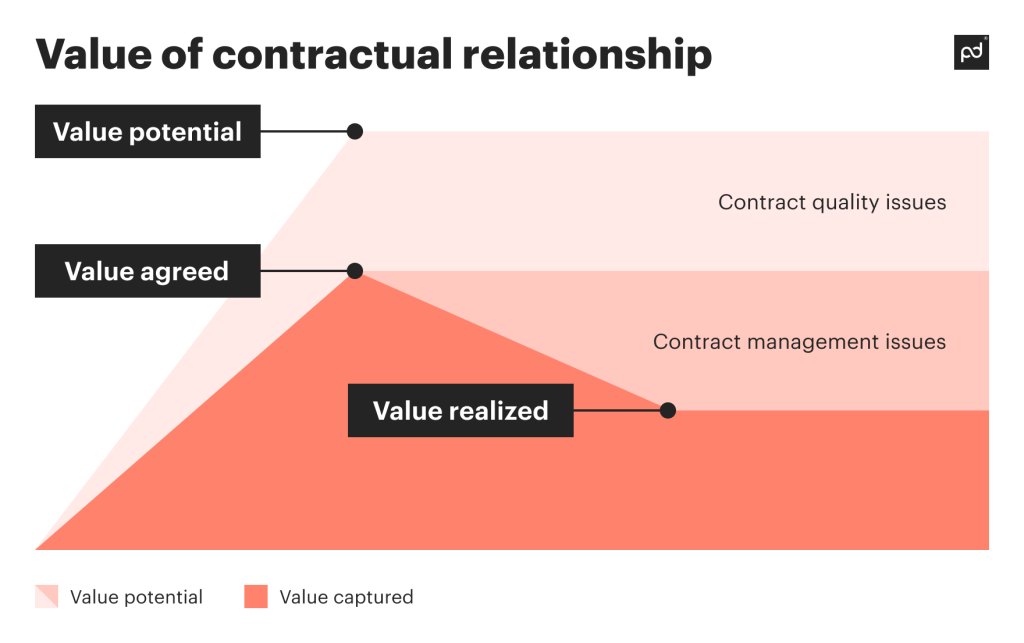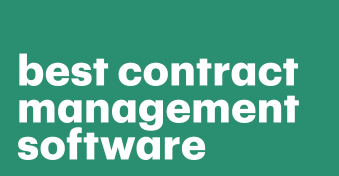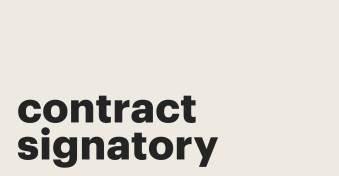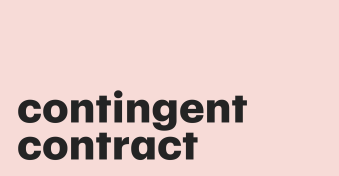In the world of sales, contract value leakage is like an “expectation vs. reality” meme.
When signing a contract, the seller expects that throughout its lifetime this contract will bring them a certain financial value.
But the harsh reality is that the actual value — the revenue generated from the given client — could be lower than expected.
This delta between expectations and reality is called contract value leakage.
Below, we’ll delve deeper into the concept of contract leakage.
We’ll identify its potential impact and reasons for its emergence, recommend value-maximizing strategies, and show examples of how these strategies address contract value leakage.
Finally, we’ll review how technologies can help streamline contract management and prevent value leakage.
Key takeaways
- Low adoption rates are a major driver of contract value leakage, and are overcome by embracing new tools and processes.
- Content-locked templates offer an efficient strategy for maintaining consistency and efficiency in contracts.
- Real-time document status alerts enhance collaboration and transparency, making the contract lifecycle faster and less risky.
- System integrations with CRMs are a perfect way to eliminate manual data entry, promoting accuracy in contract content.
- Digital transformation and modern contract management solutions are essential for mitigating value leakage and enhancing efficiency.
- Tailoring contract management tools to specific business needs is key to scaling and success.
What is contract value leakage?
As we mentioned above, contract value leakage means the loss of potential value during the lifecycle of a contract, resulting in the difference between desired and factual contract values.
It’s like a slow drip from a faucet that, over time, can amount to a significant loss.
This leakage can manifest in time wasted on manual contract creation, miscommunication due to inconsistent documents, or even legal risks from non-compliant contracts.

Going deeper
For getting an in-depth understanding of how the leakage is formed, let’s take a look at the process of creating, sending, and signing contracts.
Many small businesses still handle this process through traditional word-processing applications and email, or even through paperwork.
These manual approaches are quite time-consuming and prone to human errors and inconsistencies.
Every minute spent on monotonous copy-pasting, multiple edits, and navigating never-ending email chains is a minute taken away from core business activities.
This inefficiency can contribute to contract value leakage.
For growing and scaling businesses, the switch from brick-and-mortar contract management to standardized processes and specialized contract management software becomes more vital.
With an expanding client base and a growing team, relying on an outdated system of using a text editor and email for sending documents falls short.
Each additional client in the base makes processes longer and longer, contributing more and more to potential errors.
These factors speed up and exacerbate contract value leakage.
Two main types of contract leakage
The two main types of contract value leakage are pre-contract and post-contract leakage.
Let’s get to how they’re different.
Pre-contract leakage
Pre-contract leakage occurs during the deal design, contracting, and implementation phases.
It often stems from poor alignment between business and technical requirements, leading to over-specified or misaligned service level agreements (SLAs).
Other common causes include poorly defined scope, unknown deal-impacting variables during the contracting process, and reliance on supplier due diligence without proper verification.
Post-contract leakage
Post-contract leakage happens in the execution phase after the contract is signed and implemented.
It is often linked to the inability to capture promised benefits and can fall into three main buckets: failure to implement the service (including transition delays), sub-optimal performance monitoring, and ineffective governance.
Delays in transition, services paid for but not delivered, incorrect charging for services, and lack of rigor in the charging process are common examples.
Ineffective governance and lack of capacity or capability to manage partnerships can further exacerbate these issues.
The impact of contract value leakage on small businesses
Contract value leakage can significantly affect your business.
Here are some of the possible — and potentially dire — consequences of leakage for startups or companies with a smaller footprint:
- Contract value leakage can result in financial loss. When the expected value from a contract is not realized, it can lead to missed revenue opportunities and reduced profitability.
- Small businesses can also feel the results of value leakage in growing costs. This can occur due to non-value-added change orders or poor governance, which may lead to additional expenses or inefficiencies.
- If a small business fails to deliver the expected value due to factors like low adoption rates or lack of innovation, this can decrease their competitiveness in the market. This can result in losing clients or market share to competitors who are better able to deliver value.
- Value leakage in the form of a worsened reputation is also a possible scenario. If small businesses consistently fail to meet the expectations outlined in contracts, it can harm their credibility and make it harder to secure future contracts or partnerships.
- When value leakage occurs, small businesses may miss out on growth opportunities. This can include potential upsells, cross-sells, or long-term partnerships that could have been fostered if the value from the initial contract had been fully realized.
Now that we’ve defined the necessity for preventing contract value leakage, let’s move further and review the main causes of its occurrence.
Understanding the underlying causes is the first step in addressing the issue.
Unlocking what leads to contract value leakage
Here’s a detailed look at some of the primary causes of contract value leakage in small businesses:
Low adoption rates for new tools and processes
Introducing new contract management tools is not just about implementation; it’s about integration into the daily workflow.
For example, if a new e-signature tool is embraced by the sales team but ignored by legal, the disconnect can create bottlenecks.
Such selective adoption undermines the very efficiencies the tool was designed to create, leading to value leakage that can ripple across various business functions.
Non-value-added change requests
Every change to a contract, no matter how minor, requires time, effort, and sometimes legal review.
When changes don’t enhance the contract’s substance but merely alter its form, they can become a drain on resources.
This not only leads to leakage but can strain relationships with partners who may view constant changes as a sign of indecisiveness or lack of preparation.
Lack of innovation
In a rapidly evolving business landscape, sticking to outdated practices is akin to navigating modern markets with an ancient map.
Innovation in contract management isn’t just about technology; it’s about aligning contracts with strategic goals, leveraging data for insights, and fostering agility.
Failure to innovate can leave a business trailing its more forward-thinking competitors.
Ineffective contract negotiation practices
Contract negotiation is a delicate dance that requires a deep understanding of both parties’ needs and the market landscape.
Poor terms and price negotiation lead to unfavorable terms and can set a precedent that affects future dealings.
Training teams in negotiation skills and providing them with the right information can turn this potential leakage point into a value-add opportunity.
Scope discrepancies and disagreements
A contract’s scope is its backbone.
Ambiguities here can lead to disputes that aren’t just legal headaches but can erode trust between the parties.
Investing time in defining the scope, involving all stakeholders, and ensuring alignment with business objectives can turn the contract into a roadmap for success rather than a ticking time bomb of potential disagreements.
Failures due to over-commitment
Over-promising and under-delivering is often the shortest way to lose client trust.
And this reputational damage has a long-term effect on the one doing the promising.
Building realistic assessments of capabilities into the contract, along with clear mechanisms for handling changes, can turn a contract into a tool for managing both expectations and performance.
Weaknesses in contract quality
A contract worsened by errors, ambiguities, or omissions may invite disputes and legal hurdles.
Invest in quality control, leveraging technology for accuracy, and viewing the contract as a product that represents the business to elevate it from a mere formality to a strategic asset.
Poor contract management
Contract management is not a set-it-and-forget-it process.
It requires ongoing oversight, alignment with performance metrics, and adaptability to changing circumstances.
Poor contract management can lead to missed opportunities for renegotiation, failure to leverage volume discounts, and lack of responsiveness to market changes.
Implementing a robust contract management system is all about turning contracts into dynamic tools that drive business value.
Strategies for overcoming contract value leakage challenges
As you can see, such a wide variety of reasons as well as their myriad combinations make the occurrence of contract value leakage possible for virtually every small or medium-sized business.
And even if you haven’t faced this challenge (congratulations!), it doesn’t mean your company has inoculated itself against future potential value leakages.
Addressing these reasons requires strategic planning and execution. Below are four value-maximizing strategies to implement in different contexts.
1. Content-locked templates
Content-locked templates are pre-designed contract formats with specific clauses and terms that remain consistent.
They allow customization in non-essential areas while maintaining uniformity in critical sections.
Why it works: By locking essential clauses, these templates eliminate variations that can lead to misunderstandings or legal disputes.
They ensure that every contract aligns with the company’s legal and compliance standards, reducing the risk of errors.
Applicable to:
- Inconsistencies and inefficiencies in contract terms
- Legal disputes arising from variations in essential clauses
- Compliance risks due to non-standardized agreements
How to implement:
- Identify core clauses for consistency.
- Create templates with locked content.
- Train team members on usage.
2. Automated alerts
Automated alerts are system-generated notifications for contract milestones, deadlines, or compliance checks.
They serve as timely reminders to take necessary actions.
Why it works: Automated alerts prevent missed deadlines by providing timely reminders. They enhance efficiency and ensure that critical contract events are addressed promptly, reducing the risk of non-compliance or missed opportunities.
Applicable to:
- Ineffective negotiation leading to unfavorable contract terms
- Lack of understanding of contract best practices
- Misalignment between contract management and business goals
How to implement:
- Identify key milestones.
- Set up alerts in the contract management system.
- Monitor and adjust as needed.
3. Contract management training
Contract management training equips team members with the skills to understand, negotiate, and manage contracts effectively.
It can be tailored to various roles within the organization.
Why it works: Training enhances the team’s ability to negotiate favorable terms and manage contracts efficiently. It builds a shared understanding of contract best practices, leading to better alignment with business goals.
How to Implement:
- Assess skill gaps.
- Provide tailored training.
- Encourage continuous learning.
4. Contract management systems
Using a contract management system enables an integrated platform to manage the entire contract process, including all its parts potentially affected in terms of leakage.
They offer tools for creation, negotiation, execution, monitoring, and renewal.
Applicable to:
- Manual errors and inefficiencies in contract tracking
- Lack of visibility into contract stages
- Non-compliance risks due to disjointed contract management processes
Why it works: A contract lifecycle management system streamlines the contracting process, reducing manual effort and errors.
It offers visibility into every stage of the contract, enabling decision-making based on data and compliance monitoring.
How to Implement:
- Evaluate contract management needs.
- Select a suitable system.
- Implement clear guidelines.
The role of technology in preventing value leakages
Historical perspective of contract management
The last decade has witnessed a seismic shift in contract management, moving from cumbersome manual processes to streamlined digital solutions.
Gone are the days of physical storage, handwritten signatures, and endless paper trails.
The digital era has ushered in electronic signatures, cloud-based storage, and versioning control, transforming the way businesses handle contracts.
By the way, not all businesses went paperless, and the transition to digital contract management has been a gradual process.
Some organizations, particularly in traditional industries, have been slow to adopt new technologies, clinging to familiar but outdated practices.
Contract value leakage in numbers
Modern contract management solutions have not only enhanced efficiency but also significantly reduced the erosion of contract value — for some.
In 2023, research conducted by Deloitte, in collaboration with World Commerce & Contracting (previously IACCM), set out to update the latter’s seminal 2014 report on the true cost of poor contract management.
Their findings paint a scenario still ripe for improvement: the average loss due to CVL fell all of 0.6% across the decade (from 9.2% to 8.6%).
While those at the upper tier of mitigating CVL are doing fairly well by comparison (loss rate at only 3%), the data shows that the worst performers are hemorrhaging 20% due to average value erosion — the equivalent of taking 1 out of every 5 contracts and lighting it on fire.
Comparison of traditional vs. modern practices
The comparison between traditional and modern contract management practices reveals a night-and-day difference.
Traditional methods often led to delays, errors, and inconsistencies, while modern practices offer precision, speed, and uniformity.
For instance, our study shows that e-signatures have increased the average document close rates by 28%.
A detailed exploration of modern technological solutions
The advent of technology has brought forth a plethora of contract management solutions tailored to prevent value leakage.
Streamlining contract management is now possible through:
Customizable contract templates
Modern platforms offer customizable templates that enable businesses to quickly create similar-looking contracts containing the same essential elements.
As a result, the drafting process becomes faster and with less risk of omitting key clauses.
Content locking
Content locking is a vital feature that safeguards essential clauses from alteration, preserving legal compliance.
This function maintains the integrity of critical terms within an agreement, reducing the risk of legal disputes
System integrations
Integration with popular CRMs like HubSpot or Salesforce means you don’t need to manually populate those contract fields that are recorded in your CRM.
This makes your contracts much more accurate and saves valuable time.
Approval requirement settings
These settings allow you to route contracts to the right individuals for validation within your organization.
An automated workflow ensures that contracts meet your specific standards before execution, giving you confidence in every agreement.
Real-time document status alerts
Instant alerts help you distribute controlling duties to different team members and make all changes visible to all parties.
Such notifications make the contract lifecycle faster and less risky in terms of errors, keeping everyone on the same page.
E-signature ease of use
The ability to sign contracts electronically means you can close deals faster without the need for physical shipping.
This feature not only reduces costs but also makes contracts legally binding with just a few clicks, right from your devices.
Cloud-based storage and versioning control
Modern solutions offer secure cloud-based storage, so you can easily access your contracts from anywhere.
Versioning control lets you collaborate on a contract without losing track of changes, allowing you to efficiently track amendments and updates.
Conclusion
Embracing technological advancements in contract management to prevent contract value leakage is a necessity.
The integration of customizable templates, content locking, system integrations, approval requirement settings, and real-time document status alerts has proven to be a game-changer in maintaining contract integrity and efficiency.
Don’t let contract value leakage be the silent drain on your business’s potential.
Invest in a modern contract management solution that will push your business ahead rather than pull it backwards.
PandaDoc is an all-in-one contract management solution that can handle all your needs in terms of keeping contract value leakage under control.
See it for yourself by starting a free 14-day trial or by scheduling a free demo.
Disclaimer
PandaDoc is not a law firm, or a substitute for an attorney or law firm. This page is not intended to and does not provide legal advice. Should you have legal questions on the validity of e-signatures or digital signatures and the enforceability thereof, please consult with an attorney or law firm. Use of PandaDocs services are governed by our Terms of Use and Privacy Policy.


